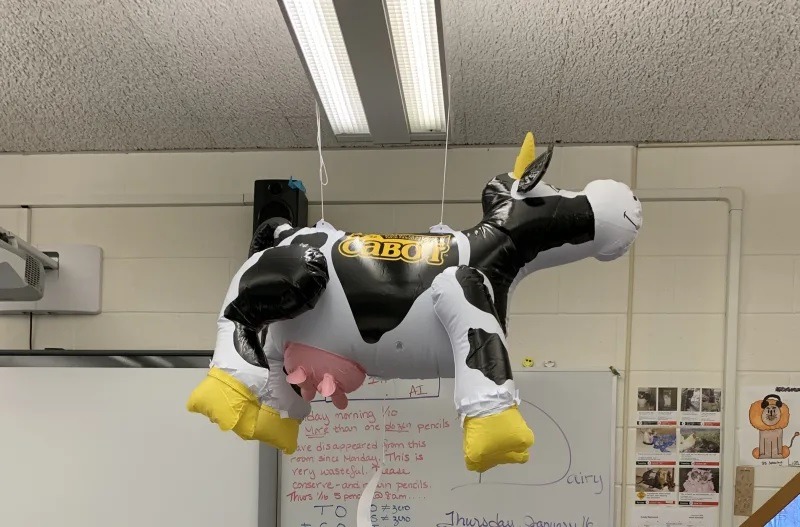The sixth grade class from Foote Elementary School in New Haven, CT asked Denise Barstow some questions about Barstow’s Longview Farm. Check out their great questions and Denise’s answers!
*note, names have been changed*
Read all about this farm to school connection here!
(Joseph) What is the approximate ratio of the weight of a cow to the amount of milk the cow produces in a day? How much does a cow weigh?
A: An average cow on our farm weighs about 1,300lbs and produces about 9.5 gallons of milk daily. – Looks like another math problem in the works!
 (Nydia) At what age can a cow first be milked?
(Nydia) At what age can a cow first be milked?
Does the age of a cow impact the amount of milk it produces?
Is there an age at which cows are “retired” from milking?
A: A cow starts giving milk after she’s given birth to her first calf at about age 2. Younger animals generally produce more milk than older cows but that isn’t always true. And we do retire our cows when they are no longer able to get pregnant (and therefore no longer able to produce milk). This usually happens between ages 8-12. That said, I know a cow right now who is producing milk and she’s 17 years old!
(April) Do pregnant cows get milked?
Who names the cows?
Does a pregnant cow produce more milk than a non-pregnant cow?
A: Yes, pregnant cows get milked. Milking is her job, and a cow will work up until about her 7th month of pregnancy – then take some time off on maternity leave! It really doesn’t make a difference in the amount or quality of milk if the cow is or is not pregnant.
We have the Name the Calf Contest at Barstow’s Dairy Store and Bakery, our farmstand. Our community is welcome to submit entries. Winners receive a photo of the calf they named and a free ice cream cone! And I’m the lucky lady who gets to select the winners (it’s the best job on the farm)!
(Ashley) Do you have to be trained or certified to milk the cows?
Do you only use machines to milk the cows or are some milked by hand?
A: All of our employees do receive a training from the farm owners on how to milk and handle our animals. Training is required through our Cooperative, Cabot AgriMark, who requires our farm to be a part of the Farmers Assuring Responsible Management (FARM) program. Every farm has its own training procedures. The owners of the farm have been milking and working with dairy head for their entire lives (38 years of experience, 61 years of experience, and 64 years of experience!). My cousin Steven also graduated from an Agricultural Vocational school.
All of our cows are milked with a robotic milker. It’s consistent and comfortable for the animals – and it’s always available. Hand milking is uncomfortable for the cows and takes a very long time. We haven’t milked cows by hand since the 1930s.
(Paul) Why are some cows not milked on some days?
How can you tell if a cow is ready to be milked?
How long does it take to milk each cow? How do you know when the cow is “done” milking?
A: All of our cows are milked at least twice per day. Our cows decide when they want to be milked and always have access to our robot milkers. The computer also spits out a report every 12 hours of the cows who haven’t visited the robot – we then know to go check in on them and make sure they get milked. The average cow milks for about 7 minutes but some take 4 minutes and some take 14 minutes. There are sensors in the system to notice when milk is no longer flowing through the tubes, this is how we know when each teat is done producing milk.
 (Rashad) How much milk does it take to make one gallon of ice cream? Does that amount vary depending on the flavor?
(Rashad) How much milk does it take to make one gallon of ice cream? Does that amount vary depending on the flavor?
What is your most popular flavor?
A: It takes about 3 gallons of milk to make 1 gallon of ice cream and flavor doesn’t make a real impact on that. We don’t make our own ice cream (we sell it from the farm next door). But my favorite flavor Maple Valley Creamery ice cream is S’mores!
(Lila) Does milk production vary by season or temperature?
What do the cows do when they are not milking?
Are the cows left outside when it is raining?
Are the cows outside in the winter?
A: YES in a big way! This is the primary cause of fluctuation in milk supply. Cows hate the heat so they produce less milk in the summer time and lots more in the winter. When our cows are milking, they stay in the barn all of the time so we don’t have to go find them in the woods or the field every time they have to milk. When they are on “maternity leave” they have access to pasture in the spring, summer, and fall when there is forage for them to eat on the ground. They also always have access to the barn in case they want to enjoy the shade, a bed, or time out of the rain. They are not allowed outside in the winter (a wet and cold cow can be a very dangerous situation to her health).
When our cows are not milking, they spend about 14 hours a day laying down, resting, and chewing her cud. She’ll sleep for about 30 minutes in a day. Cows eat for around 6 hours per day. About 30 minutes of her day is spent milking and the remaining 3 hours is spent socializing with other animals and farmers.
(John) How much milk does it take to make one stick of butter?
A: It takes about 2.5 gallons of milk to make 1lb of butter – one stick of butter is 1/4lb, can you do the math? ☺
(Esther) Are there some days when you have “too much milk”? How much milk can you store?
A: Esther, this is such a huge question! Yes! This country does have too much milk which is the reason for the dairy crisis, farm closings, and consolidation in the industry! It’s a terrible tragedy that will result in the loss and devastation of family farm businesses, regional economies, and rural communities.
We have an 8,000 gallon refrigerated bulk tank on our farm and it is purposefully too large to fill with all of the milk we produce. That means we don’t have overflow problems here at the farm. Every other day, Cabot Agrimark picks the milk up in a big truck and takes it to a factory to be processed into the dairy products we enjoy.
(E continued) Why does the amount of milk a cow produces vary from day to day?
A: There are lots of reasons for that but the primary reason is almost always the temperature outside. On hot days the cows produce a lot less, on cool days they produce more, on cold days they produce slightly less. Other factors might be: stress (is something in the barn noisy? Has the daily routine been changed?), feed quality and quantity, animal health (unhealthy cows produce less milk). Our goal is to keep every day as consistent and comfortable for our cows as possible. That means: sticking to a routine, using quiet voices, moving slowly around our animals, feeding top quality food, monitoring animal health and wellness, and making sure our cows are comfortable and happy!
(E continued) How does a cow turn grass into milk?
A: Cows belong to a group of animals called ruminants. Ruminants are animals that have four stomach compartments that play different roles in the digestion of food. The four stomach compartments are: the rumen, reticulum, omasum, and abomasum. Cows begin the milk making process by half-chewing their grass before swallowing it into her first stomach – rumen. The grass mixes with water in the rumen and is then broken down by stomach juices and microbes. Once broken down the grass then enters reticulum. Once in the reticulum the grass is softened and made into small wads calls cuds. The cuds then return up to the cow’s mouth where it is then again chewed for about one minute. Cows then swallow the cuds into the omasum compartment of their stomach. There, it is pressed to remove water and broken down even further. Finally, the cud enters the fourth stomach compartment, the abomasum, is digested. The digested grass then passes through the small intestine where essential nutrients stay to keep cows strong and healthy.
The nutrients the cows receive from eating the grass are then turned into milk by four mammary glands in the udder after about 2 or 3 days. Once the nutrients have turned to milk, the cows are then ready then to produce the milk.
(Greg) Has the herd size increased because of births? Or did you buy more cows? From whom do you buy cows? Do you have bulls in your herd?
A: We bought 76 cows this year. We were trying to grow our herd internally, but our cooperative has placed a growth restriction on the participating farms beginning January 1 in an effort to slow milk production. Because we installed an additional robot milker and put an addition on our barn, we needed to buy some cows to help pay our bills with milk!
We purchased our cows from farms going out of business in Connecticut and Vermont, along with 7 from the University of New Hampshire, and 9 from the University of Vermont.
We have 20 steers in our herd that we raise for beef.
